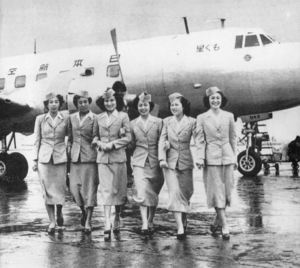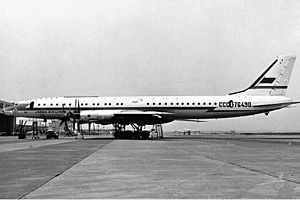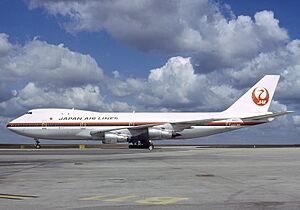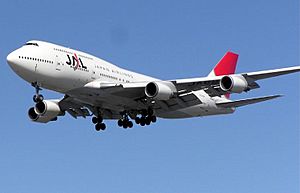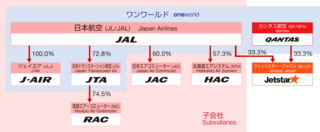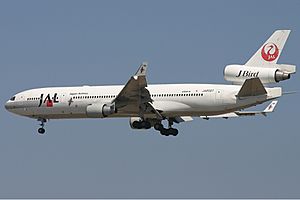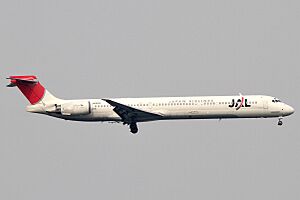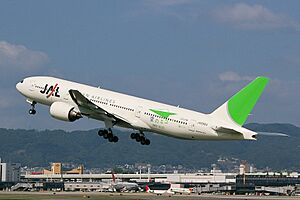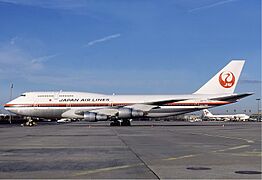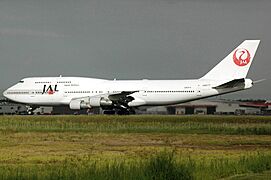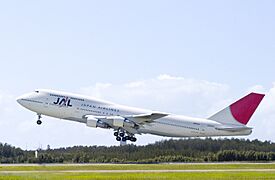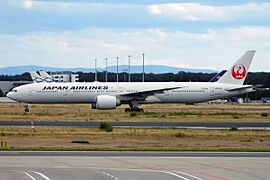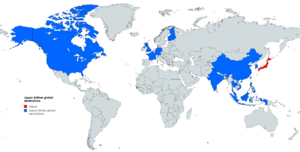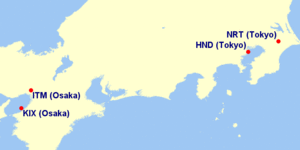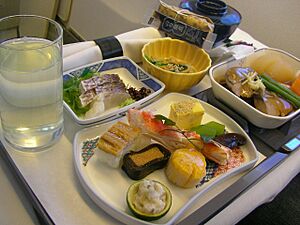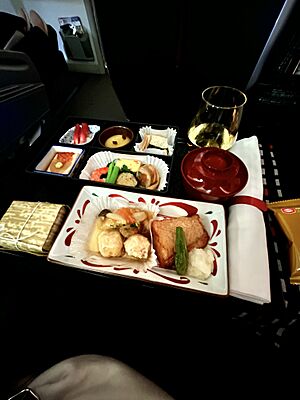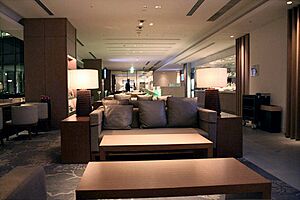Japan Airlines facts for kids
A Japan Airlines Airbus A350
|
|
| Founded | 1 August 1951 (as Japan Air Lines) |
|---|---|
| Hubs | |
| Secondary hubs |
|
| Focus cities |
|
| Frequent-flyer program |
|
| Alliance | Oneworld |
| Subsidiaries |
|
| Fleet size | 146 (mainline) |
| Destinations | 91 |
| Parent company | JAL Group |
| Headquarters | Shinagawa, Tokyo, Japan |
| Key people | |
| Revenue | |
| Operating income | |
| Net income | |
Japan Airlines (JAL) is a major airline from Japan. It is based in Shinagawa, Tokyo. JAL is the second-largest airline in Japan, right after All Nippon Airways (ANA). Many people consider it the national airline of Japan because of its long history.
JAL's main airports are Tokyo's Narita and Haneda. It also has important airports in Osaka, called Kansai and Itami. The JAL Group includes Japan Airlines and other smaller airlines like J-Air, Japan Air Commuter, Japan Transocean Air, Hokkaido Air System, and Ryukyu Air Commuter. These smaller airlines help with flights inside Japan. JAL Cargo handles all the shipping of goods and mail.
The JAL Group flies to 220 places in 35 countries around the world. This includes both regular flights and special flights for passengers and cargo. They also have "codeshare agreements," which means they share flights with other airlines. The group has a fleet of 279 airplanes. Japan Airlines, J-Air, JAL Express, and Japan Transocean Air are all part of the Oneworld airline alliance. An airline alliance is a group of airlines that work together to offer more destinations and benefits to their passengers.
JAL started in 1951 as a company owned by the government. It became the official national airline of Japan in 1953. After more than 30 years of flying and growing, the airline became fully private in 1987. This means it was no longer owned by the government. In 2002, JAL joined with Japan Air System (JAS), which was Japan's third-largest airline. After this merger, JAL became the sixth-largest airline in the world based on how many passengers it carried.
Contents
History of Japan Airlines
Early Years and Growth
Starting the Airline
Japan Airlines Co. was created on August 1, 1951. The Japanese government wanted a good air travel system to help Japan recover after World War II. The airline started with ¥100 million (Japanese Yen) and had its main office in Ginza, Tokyo.
From August 27 to 29, JAL flew special invitation flights using a Douglas DC-3 airplane. On October 25, Japan's first domestic airline service after the war began. They used a Martin 2-0-2 plane, called Mokusei, and crew members from another airline.
On August 1, 1953, the government passed a law to create a new state-owned Japan Airlines. This new company took over everything from the private company on October 1. By 1953, JAL flew from Tokyo to cities like Sapporo, Misawa, Nagoya, Osaka, Iwakuni, and Fukuoka.
On February 2, 1954, JAL started its first international flights. It carried 18 passengers from Tokyo to San Francisco on a Douglas DC-6B called City of Tokyo. The plane stopped in Wake Island and Honolulu along the way. To remember this first international service, the flights between Tokyo and San Francisco are still called Flights 1 and 2 today.
In the 1950s, JAL used different types of planes, including Douglas DC-4s and Douglas DC-7Cs. By 1955, JAL flew to Hong Kong through Okinawa. By 1958, the Hong Kong route went even further to Bangkok and Singapore. In 1959, JAL could fly nonstop between Seattle and Tokyo using its DC-7Cs.
Entering the Jet Age
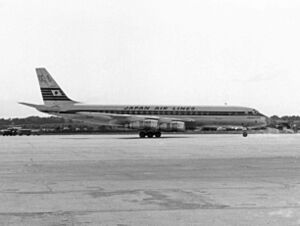
In 1960, JAL received its first jet airplane, a Douglas DC-8 named Fuji. This jet started flying on the Tokyo-Honolulu-San Francisco route. JAL eventually had 51 DC-8 planes, and the last one was retired in 1987. The Fuji plane flew until 1974 and was then used for training. Its front part is now on display at the JAL Sky Museum.
JAL also started flying to Seattle and Hong Kong in 1960. By the end of 1961, JAL had flights that went over the North Pole from Tokyo to Seattle, Copenhagen, London, and Paris, stopping in Anchorage, Alaska. They also flew to Los Angeles and San Francisco through Honolulu, Hawaii.
During the 1960s, JAL added many new cities to its routes, including Moscow, New York, and Busan. Jet flights to Europe through Anchorage began in 1961. Flights to Europe through India started in 1962.
By 1965, Japan Airlines had its main office in the Tokyo Building. At this time, more than half of JAL's money came from flights across the Pacific Ocean to the United States. JAL wanted to fly routes across the Atlantic Ocean from the East Coast of the U.S. The transpacific route was extended from San Francisco to New York in November 1966 and to London in 1967.
Between 1967 and 1969, JAL worked with Aeroflot, a Soviet airline, to offer flights between Tokyo and Moscow. They used a Soviet Tupolev Tu-114 plane. The flight crew included one JAL member, and the cabin crew had five members from each airline.
In 1972, the Japanese government made a rule that said JAL was the official national airline for international flights. JAL was also allowed to fly on major domestic routes, competing with ANA and Toa Domestic Airlines.
In 1974, an agreement between China and Japan caused flights between Taiwan and Japan to stop. A new airline called Japan Asia Airways was created in 1975 to restart flights between the two countries. In the 1970s, JAL bought the Boeing 747 and McDonnell Douglas DC-10 planes for its growing routes.
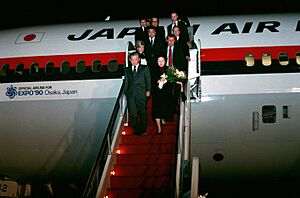
In the 1980s, JAL flew special flights for important people like Crown Prince Akihito and Crown Princess Michiko, Pope John Paul II, and Japanese prime ministers. Before Japan had its own special government planes, two Boeing 747-400s from JAL were used as Japanese Air Force One and Japanese Air Force Two. During this time, JAL added new Boeing 747-100SR, Boeing 747-SUD, and Boeing 767 jets to its fleet. It also retired its older Boeing 727s and Douglas DC-8s.
In 1978, JAL started flights to São Paulo and Rio de Janeiro in Brazil. These flights stopped in Anchorage and San Juan. The stopover later changed to Los Angeles in 1982 and then to New York's John F. Kennedy International Airport in 1999.
Modern Era and Changes
Japan started thinking about allowing more competition in airlines in the late 1970s. In 1985, the government announced it would change the old system. In 1987, Japan Airlines became fully private. This meant other Japanese airlines, All Nippon Airways and Japan Air System, could now compete with JAL on both domestic and international routes. Because of this new competition, JAL changed how it was organized. It split into three main parts: international passenger service, domestic passenger service, and cargo service.
Challenges and Recovery
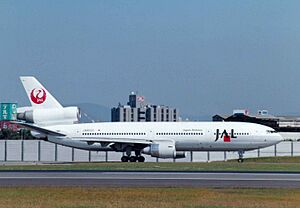
In the early 1990s, Japan Airlines flew special flights to help Japanese citizens leave Iraq before the Gulf War began. In October 1990, a new company called Japan Air Charter was started. In September 1996, JAL became the official airline of Tokyo Disneyland through an agreement with the Walt Disney Company. JAL Express was created in April 1997, using Boeing 737 planes.
During the 1990s, JAL faced money problems because of economic slowdowns in the United States, the United Kingdom, and Japan. Even though the airline had made profits since 1986, it started losing money in 1992. To save money, JAL created the lower-cost JAL Express for domestic flights and moved tourist flights to JALways. These changes helped the airline become profitable again by 1999.
In 1997, JAL flew Japanese Prime Minister Ryutaro Hashimoto to Peru to help with a hostage situation at the Japanese embassy. Japan Airlines also ordered new Boeing 777 planes in the 1990s to update its fleet. JAL was one of eight airlines that helped design the Boeing 777, making sure it met their needs.
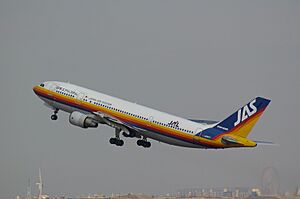
In 2001, Japan Air System and Japan Airlines decided to merge. On October 2, 2002, they formed a new main company called Japan Airlines System. This created the new JAL Group. The paint schemes on the planes were changed to match the new JAL Group design. At that time, the combined airlines were the sixth largest in the world by the number of passengers they carried.
On April 1, 2004, JAL changed its name to Japan Airlines International, and JAS changed its name to Japan Airlines Domestic. All JAS flight codes and check-in desks were changed to JAL. On June 26, 2004, the main company, Japan Airlines System, was renamed Japan Airlines Corporation.
After the merger, two companies operated under the JAL brand: Japan Airlines International and Japan Airlines Domestic. Japan Airlines Domestic handled most of JAL's flights within Japan, while JAL International flew both international and major domestic routes. On October 1, 2006, these two companies merged into one, called Japan Airlines International.
JAL applied to join the Oneworld airline alliance on October 25, 2005. JAL believed that joining Oneworld would help the airline grow and offer better service to its customers. Japan Airlines, along with Malév and Royal Jordanian, officially joined the alliance on April 1, 2007.
On April 1, 2008, JAL combined its subsidiary Japan Asia Airways (JAA) with its main operations. JAA had flown all JAL Group flights between Japan and Taiwan from 1975 to 2008. This was because of Taiwan's special political situation.
In 2009, Japan Airlines faced big financial losses, even though it was still Asia's largest airline by revenue. To save money, the airline cut jobs and reduced some flight routes. The Japanese government also gave the airline ¥100 billion to help it. In September 2009, the Japanese government created a special team to help JAL recover. This team looked at ways to cut costs and find new partners. Haruka Nishimatsu, the CEO of JAL at the time, even cut his own salary to the same amount as JAL pilots to show his commitment during the crisis.
One idea was for JAL to merge with ANA, which would create one very large international airline. However, ANA was doing better financially on its own and was not interested. The special team also looked at possible partnerships with airlines from other countries.
After much discussion, JAL asked for special protection under a law that helps companies recover from financial trouble on January 19, 2010. JAL received ¥300 billion and had ¥730 billion in debts removed. In return, it had to cut its capital to zero, stop flying on routes that were losing money, and reduce its workforce by 15,700 employees. JAL's shares were removed from the Tokyo Stock Exchange on February 20, 2010. At the time, this was the largest bankruptcy in Japan for a non-financial company.
Kazuo Inamori, who founded Kyocera and KDDI, became the new CEO of JAL. The transport minister personally asked Inamori to take the job, believing that a successful business leader was needed to fix JAL's problems. Japan Air Commuter president Masaru Onishi became the new president of JAL.
By May, JAL started to see more passengers. In August, it was announced that JAL would cut 19,133 jobs by March 2015. This was part of their plan to make the business successful again.
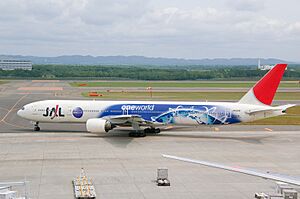
Even though JAL stayed in the Oneworld alliance after its bankruptcy, it had considered joining the SkyTeam alliance and getting money from Delta Air Lines between September 2009 and February 2010. JAL also talked with SkyTeam members Air France-KLM and Korean Air.
The Japanese government liked the idea of a deal with Delta because Delta had a large global network and a big presence in Japan. The government also supported a deal with Air France-KLM because it was a "healthier company" than American Airlines.
American Airlines planned to work with Oneworld partners British Airways and Qantas to offer money to JAL. British Airways tried to convince JAL to stay with Oneworld. American CEO Gerard Arpey also encouraged JAL to remain with Oneworld.
On January 1, 2010, JAL president Haruka Nishimatsu said he preferred a partnership with Delta over American. However, both JAL and American denied reports that a deal with Delta was certain. The Wall Street Journal then reported that American Airlines increased its offer to JAL by $300 million, making it $1.4 billion.
After JAL filed for bankruptcy, there were more reports that JAL would leave Oneworld for SkyTeam. But JAL president Masaru Onishi said on February 1 that the new leaders were looking at the situation carefully.
On February 7, news outlets reported that JAL would stay with American Airlines and end talks with Delta. The leaders decided that switching alliances would be too risky and could slow down JAL's recovery. Two days later, JAL officially announced it would strengthen its partnership with American and other Oneworld airlines.
JAL successfully came out of bankruptcy protection in March 2011. In July, they started plans to sell their shares back to the public. On January 6, 2012, JAL announced it would relist its shares on the Tokyo Stock Exchange. This was completed on September 19, 2012. The government agency that helped JAL recover sold all its shares for ¥650 billion, which was more than its original investment.
After leaving bankruptcy, JAL started new partnerships within the Oneworld alliance. A joint business with JAL and American for flights across the Pacific began in April 2011. JAL also formed Jetstar Japan, a lower-cost airline, with Qantas in July. In 2012, JAL and British Airways applied to work together on flights between Japan and Europe. Finnair joined this partnership in July 2013, as JAL started new nonstop flights to Helsinki.
Recent Developments
Between 2020 and 2021, Japan Airlines added many safety measures to stop the spread of the COVID-19 pandemic. JAL uses "JAL FlySafe" hygiene rules to keep passengers safe. These include airport staff wearing masks, cleaning seats and surfaces often, and sanitizing bathroom handles.
On June 18, 2021, Japan Airlines announced its first flight using two different types of Sustainable Aviation Fuel (SAF) made in Japan. The flight went from Tokyo (Haneda) to Sapporo (Shin-Chitose). It used SAF made from wood chips and microalgae. This was the first flight in the world to use biofuel from gasified wood chips and to mix two different types of biofuels.
In May 2023, JAL said it would bring back special cargo flights using Boeing 767-300BCF planes. These planes were changed from passenger planes. This service started in early 2024. JAL had retired its old Boeing 747 cargo planes in 2011.
Leadership
- Chairman: Yuji Akasaka (since April 2024)
- President and CEO: Mitsuko Tottori (since April 2024)
In January 2024, the company announced that Mitsuko Tottori would become president, taking over from Yuji Akasaka. As of April 1, 2024, Tottori became the first female president in the company's history. She started her career as a flight attendant in 1985. With over 30 years of experience, Tottori was a senior director in charge of cabin safety and passenger service. Akasaka became the chairman.
How JAL is Organized
Besides its main flights, JAL owns five smaller airlines that help with or add to JAL's main flights:
- J-Air (JLJ) – flies regional jets, based in Itami Airport. It is a member of Oneworld.
- Japan Air Commuter (JAC) – flies turboprop planes, based in Kagoshima. It is a member of Oneworld.
- Hokkaido Air System (HAC) – flies turboprop planes, based in Hokkaido. It is a member of Oneworld.
- Japan Transocean Air (JTA) – flies jets from/to Okinawa. It is a member of Oneworld.
- Ryukyu Air Commuter (RAC) – flies turboprop planes, based in Okinawa.
Some companies that used to be part of JAL:
- JALways was JAL's international company for flights to vacation spots.
- JAL Express (JEX) was JAL's lower-cost airline for jet flights between smaller cities. It merged with Japan Airlines in 2014.
- Japan Asia Airways (JAA) was created in 1975. It allowed JAL to fly to Taiwan without causing problems with China. JAA was closed in 2008 when JAL became private, allowing JAL to fly to Taiwan directly.
JALUX Inc., started in 1962, is a company that buys things for JAL. This includes JAL SELECTION products, in-flight meals, supplies for airport shops, airplane fuel parts, and duty-free items.
JAL Cargo is the name for the airline group's shipping service. It is part of the WOW cargo alliance. In the year ending March 31, 2009, the cargo part of JAL carried over 500,000 tons of goods within Japan and over 627,000 tons internationally.
On April 1, 2011, the airline changed its official trade name to Japan Airlines Co., Ltd. In early 2019, JAL launched a new lower-cost airline called Zipair Tokyo. It focuses on medium to long-distance flights and started flying in summer 2020.
JAL Headquarters
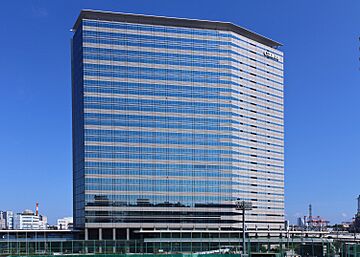
JAL's main office is in the Nomura Fudosan Tennozu Building. This building is located on Tennōzu Isle in Shinagawa, Tokyo. It has 26 floors above ground and two underground levels.
Several parts of JAL, like JALPAK (for travel packages) and JAL Hotels, are in this building. The Japan office of American Airlines is also there. People sometimes call it the JAL Building.
When JAL first started in 1951, its headquarters were in Ginza, Tokyo. By 1965, JAL's main office was in the Tokyo Building in Marunouchi, Tokyo.
On June 28, 1996, the JAL Building was finished. JAL moved its headquarters there on July 27, 1996. The Flight Operation Center in the JAL Building started on September 20, 1996. The main office for Japan Airlines System (JALS), the company formed when JAL and Japan Air System merged, also moved to the JAL Building in 2003.
Airplane Designs (Liveries)
Logos and Main Designs
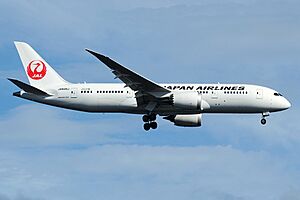
JAL's airplane design is called the tsurumaru or "crane circle." It shows a Japanese red-crowned crane with its wings spread out. Jerry Huff created the Tsurumaru JAL logo in 1958. He was inspired by the family symbols of Samurai warriors. He chose the crane because it represents loyalty (it mates for life) and strength (it flies high for a long time without getting tired).
The tsurumaru design was used until 2002. Then, it was replaced by a design called the "Arc of the Sun." This design had a rising sun shape on a creamy background.
JAL strongly supports UNICEF and shows this by having a "We Support UNICEF" logo on each plane.
After its financial restructuring, Japan Airlines brought back the classic tsurumaru logo starting on April 1, 2011.
Special Designs

JAL is known for using special designs on its planes. For example, a Boeing 747 (JA8908) had a World Cup soccer design in 2002. Another Boeing 747 (JA8907) was the Matsui Jet, featuring the famous Japanese baseball player Hideki Matsui in 2003. One of the airline's Boeing 767-300 (JA8253) was the Expo 2005 plane.
Many JAL planes also have a Yokoso Japan logo to support the "Visit Japan" campaign. In late 2005, Japan Airlines started using a Boeing 777 (JA8941) that featured Japanese actor Shingo Katori on one side and the television series Saiyuki on the other.
JAL has also used designs featuring Tokyo Disneyland and Tokyo DisneySea, as it is the official airline of the Tokyo Disney Resort.
In April 2007, JAL showed off a Boeing 777-300 (JA8941) with a special Oneworld design. This was to promote the airline joining the global airline alliance.
JAL repainted a Boeing 777-200 (JA8984) in 2008 and a Boeing 777-300ER (JA731J) in 2009 to have a green arc on its tail instead of red. They also added a green origami airplane on the side and called them the Eco Jet. This showed the company's efforts to reduce harm to the environment.
In 2009, JAL repainted JA8941 again, as well as a JTA 737-400 (JA8933), to promote the music group Kobukuro and their new album.
On September 4, 2010, JAL and the music group Arashi introduced a new design on one of its Boeing 777-200 (JA8982). It featured the five members of Arashi. In May 2019, JAL also painted a Boeing 787-9 (JA873J) with the ARASHI HAWAII JET design. In November, an Airbus A350-900 (JA04XJ) was painted with the 20th ARASHI THANKS JET design to celebrate the band's 20th anniversary.
On August 3, 2017, JAL announced a new design on an Embraer 190 from its subsidiary J-Air. This was to celebrate the new Despicable Me: Minion Mayhem ride at Universal Studios Japan.
Starting in April 2019, JAL introduced the 'Tokyo 2020, Fly For it!' series of special designs. These celebrated the Tokyo 2020 Olympics and featured the two mascots, Miraitowa and Someity. Two JAL planes, a Boeing 777-200 (JA773J) and a Boeing 767-300ER (JA601J), were painted with these designs.
In December 2022, JAL and The Walt Disney Company Japan introduced a special design on a Boeing 767-300ER (JA615J). This was to celebrate the "Disney 100 Years of Wonder" for Walt Disney Company's 100th anniversary in 2023.
Where JAL Flies
Japan Airlines flies to 60 places within Japan and 39 international places in Asia, the Americas, Europe, and Oceania. This does not include flights they share with other airlines. JAL's international main airports are Tokyo's Narita International Airport and Haneda Airport, and Osaka's Kansai International Airport and Itami Airport. Japan Airlines and its smaller airlines currently fly over 4,500 international flights and 26,000 domestic flights each month.
In the year ending March 31, 2009, JAL added or increased flights on ten international routes, like Tokyo (Narita) to New York City. They stopped flying on four international routes. Within Japan, JAL stopped 14 routes. Also, the airline increased its codesharing with other airlines in the Oneworld alliance, like American Airlines and British Airways, and with other airlines like Air France and China Eastern.
For many years, Narita International Airport was the main airport for international and cargo flights. Today, Haneda Airport is becoming a major international airport because it is very close to Tokyo metropolis and is growing a lot.
Japan Airlines shares flights with these airlines:
- Aeroméxico
- airBaltic
- Air France
- Air Astana
- Air Tahiti Nui
- Aircalin
- Alaska Airlines
- Amakusa Airlines
- Bangkok Airways
- Cathay Pacific
- China Airlines
- China Eastern Airlines
- China Southern Airlines
- Emirates
- Fiji Airways
- Fuji Dream Airlines
- Garuda Indonesia
- IndiGo
- Japan Transocean Air (Subsidiary)
- JetBlue
- Jetstar Japan (Subsidiary)
- Kalitta Air
- Korean Air
- LATAM Brasil
- LATAM Chile
- Malaysia Airlines
- MIAT Mongolian Airlines
- Oriental Air Bridge
- Qatar Airways
- Royal Brunei Airlines
- Shanghai Airlines
- Spring Japan (Subsidiary)
- SriLankan Airlines
- VietJet Air
- WestJet
- XiamenAir
Joint Ventures
Japan Airlines also has special business agreements, called joint ventures, with these airlines:
JAL's Airplanes
Services on Board
Cabin Classes
A350-1000 Cabins
In January 2024, Japan Airlines introduced new cabins on its A350-1000 planes. These cabins include First, Business, Premium Economy, and Economy class. The First and Business class cabins have private enclosed suites and in-seat audio. The A350-1000 has 6 First class seats, 54 Business class seats, 24 Premium Economy seats, and 155 Economy seats.
Other Cabins
JAL has introduced new international First and Business Class seats. The JAL Suite for First Class is 20 percent larger than older seats. The JAL Shell Flat Neo Seat for Business Class is a newer version of an older seat, with a wider design. These new seats, along with Premium Economy seats, first appeared on flights between Tokyo and New York on August 1, 2008. They later expanded to other routes like Tokyo to San Francisco, Chicago, and Los Angeles.
In 2013, JAL introduced new Economy and Premium Economy seats called Sky Premium and Sky Wider Economy. Sky Premium seats have more legroom. Sky Wider Economy seats are slimmer, giving passengers more legroom and width. Newer 787 planes have an even newer version called Sky Wider II, with even more legroom and width.
In premium cabins, JAL introduced fully flat beds, called Sky Suite in Business Class and improved First Suite seats in First Class. The Sky Suite in Business Class allows all passengers to easily reach the aisle. These are found on JAL's Boeing 777-300ER, 787-8, and some 787-9 planes. In 2015, JAL introduced Sky Suite II for its international 767-300ER planes. In 2016, JAL introduced Sky Suite III for its Boeing 777-200ER and some 787-9 planes. These are often used on shorter international flights.
International Services
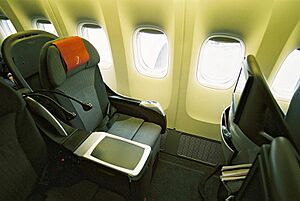
For international flights, JAL offers different classes:
- JAL First Class JAL Suite: These seats recline fully and have real leather.
- JAL Business Class JAL Sky Suite, JAL Sky Suite II, JAL Sky Suite III, JAL Shell Flat NEO, JAL Skyluxe Seat, or JAL Skyrecliner.
- JAL Premium Economy JAL Sky Premium.
- JAL Economy Class JAL Economy Class Seat or JAL Sky Wider.
Domestic Services in Japan
For flights within Japan, JAL offers First Class, Executive (Business) Class Class J, and Economy Class. The First Class seat is made from high-quality leather and is very wide. Class J seats are designed to be comfortable and help passengers relax.
In-flight Entertainment
MAGIC System
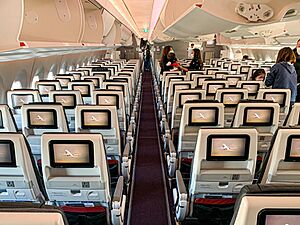
MAGIC is JAL's entertainment system on the plane. It has the newest movies, videos, games, and music. There are six versions of the MAGIC system. The MAGIC-III system, introduced in 2007, lets passengers choose what they want to watch or listen to. The number of movies, music, and games was doubled by 2008. This system is on all seats on Boeing 767-300ER, 777-200ER, and 777-300ER planes.
Older MAGIC systems have movies that start automatically. Passengers in Economy class can watch the movie already playing. Passengers in Business and First Class can choose what they want to watch. MAGIC systems also show JAL's duty-free shopping catalog. MAGIC-V has a touchscreen and USB ports. MAGIC-VI is on some newer Boeing 787-8s and 777-300s.
Aircraft Cameras
On most JAL international flights, there are cameras on the plane, either on the wings, belly, or tail. When the plane is moving on the ground, taking off, or landing, the TVs in the cabin automatically show the view from these cameras. This gives passengers a "Pilot Vision." However, some newer entertainment systems do not have these cameras anymore, except for the airline's new A350s.
Other Media
Skyward is the airline group's magazine on the plane. Its name comes from the company's motto, "Dream Skyward." All JAL Group magazines are provided by JALUX.
In a special event from June 1 to August 31, 2006, passengers in Business and First Class could use Nintendo DS Lites. These were specially made for air travel, with wireless features removed for safety.
JAL also offers some passengers a VR experience using Samsung Gear VR. Passengers can watch special programs about places like Germany and Argentina.
Food and Drinks (Catering)
Japan Airlines offers meals on long-distance international flights. The type of meal depends on the cabin class, destination, and flight length. They usually offer both Western and Japanese food, with special seasonal menus. The airline has worked with famous chefs to create its menus. In 2016, they launched a children's menu created by several chefs.
Sakura Lounge
Sakura Lounge is Japan Airlines' special airport lounge. "Sakura" is the Japanese word for cherry blossom. JAL also has other international lounges, including First Class Lounge, and domestic lounges like Diamond Premier Lounge. Passengers can use these lounges depending on their ticket class or their membership status in JAL Mileage Bank or JAL Global Club.
Sports Sponsorship
In June 2024, Japan Airlines announced a partnership with Liverpool F.C., becoming the club's official airline partner. Japan Airlines also sponsors Japanese football clubs Shimizu S-Pulse and Consadole Sapporo.
Awards and Recognition
On June 24, 2024, Skytrax voted Japan Airlines the 2024 World's Best Premium Economy Class.
Incidents and Accidents
See also
 In Spanish: Japan Airlines para niños
In Spanish: Japan Airlines para niños
- Air transport in Japan
- List of airports in Japan
- List of airlines of Japan
- Tokyu Corporation
- Japan Air System


